Named after one of the area’s early Mormon settlers, Bryce Canyon National Park sits among an all-star cast of five stunning national parks in southwest Utah. Fewer than three hours from the Grand Canyon and about two hours from Zion, Bryce tends to be bypassed by visitors who are drawn to its larger, more accessible neighbors. But for those who make the effort, the park offers an incredible reward. Martian landscapes of pillar-shaped red rocks mesmerize photographers at sunrise and sunset, high alpine meadows and forests lure hikers down winding trails, and one of the darkest night skies in North America is more than enough to make most stargazers drool on their telescopes.
Ready to learn more? Here’s what our guide of this off-the-beaten-path gem will include:
- Why visit Bryce Canyon National Park: From stargazing under one of the darkest skies in the country to ranger-led hikes that unearth the geologic voodoo of hoodoos, the park’s signature rock stars, find out what makes Bryce Canyon one of the most unique destinations in the American Southwest.
- Things to do in Bryce Canyon National Park: Whether you want to unleash your inner Carl Sagan under a stunning night sky, tackle dusty trails on horseback or explore the backcountry on foot, find out what logistics you need to consider when planning your next trip to Bryce Canyon.
- How to visit Bryce Canyon National Park: The best part about vacation is being able to kick back and relax once you’ve arrived! Iron out all the logistics ahead of time—like what activities top your list, whether you’ll drive or fly, and if you want to sleep under the stars or settle in at a lodge.
Why Visit Bryce Canyon National Park
Saturated in shades of red, orange and pink, Bryce Canyon National Park is a collection of otherworldly geological formations carved into the edge of an alpine plateau. Red-rock amphitheaters, natural bridges and distinctive rock pillars—called hoodoos—form a surreal landscape punctuated by the gnarled trunks of the oldest living trees on earth, the bristlecone pine.
During the day, adventurers take to a web of trails on foot or on horseback to reach breathtaking vistas. At night, stargazers turn their gaze skyward, where the cosmos’ brightness explodes into view thanks to the park’s remote location and air quality.
The winter brings freezing temperatures and regular snowfall, offering snowshoers and cross-country skiers the chance to explore a red-rock landscape dusted in white. Between trailheads, scenic roads lead visitors through meadows and forests of aromatic piñon pine where mule deer, foxes and bobcats make their home.
While many visitors who come to Bryce Canyon National Park do so merely to escape the crowds of Zion and the Grand Canyon, those who visit become lifelong fans. It’s far more than an alternative; it’s an entirely unique environment filled with surprises around every corner.
Things to Do in Bryce Canyon National Park
Thor’s Hammer
Perhaps the most famous hoodoo in the park, Thor’s Hammer—a towering, hammerhead-looking rock supported by a skinny spire—is striking for its form and its isolation. Nearby, a maze of hoodoos and tightly packed fins form what’s known as the Silent City. Bring your camera; Thor’s Hammer is a shot you won’t want to miss.
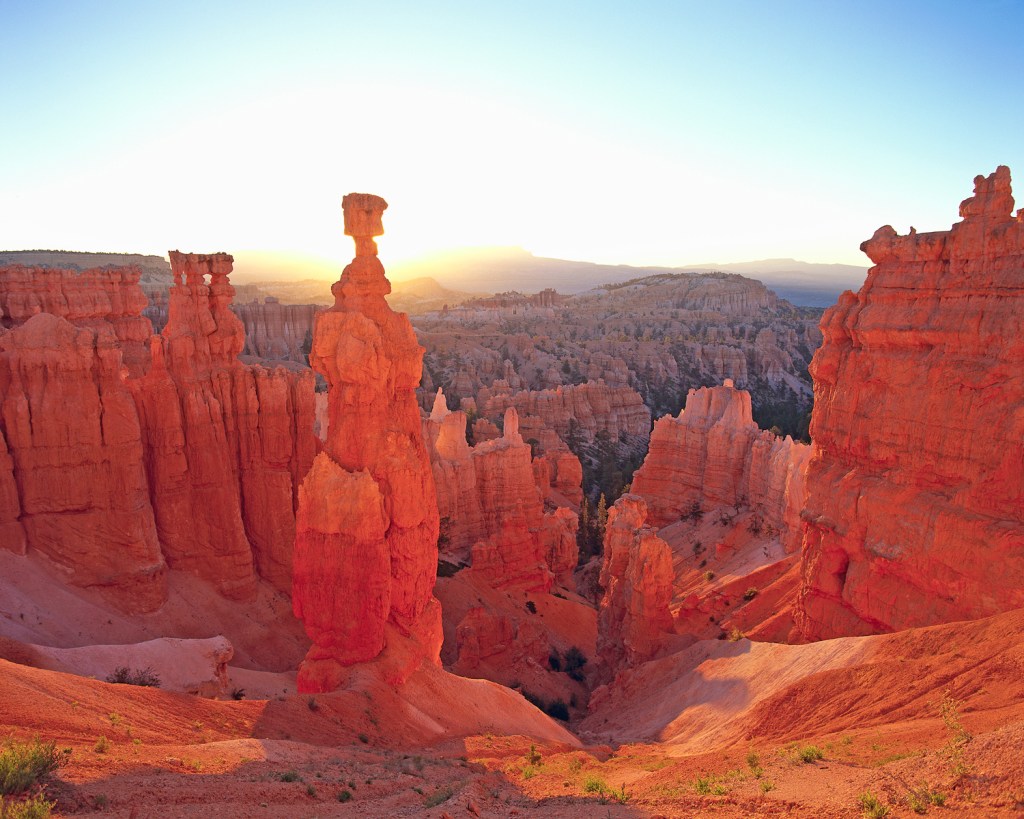
Thor’s Hammer towers above the red rocks of Bryce Canyon.
Wall Street
One of the only sections of the park that narrows to a slot canyon, Wall Street winds hikers through a narrow passage between soaring rock fins and centuries-old Douglas-fir trees. For all its stunning beauty, caution should be exercised here: Wall Street experiences the most rockfalls of any area in the park; in 2006, Wall Street closed for more than a year because of a fall that buried a 60-foot stretch of trail under 15 feet of rock.
Bryce Amphitheater
The Bryce Amphitheater is the park’s most iconic and most-visited area, and rightly so. A kaleidoscope of color at sunrise and sunset, this expansive bowl dropping away from the rim is home to many of its top sites, including Thor’s Hammer, the Three Wise Men and the slot canyon known as Wall Street. It is jam-packed with hoodoos, some just a few feet tall, others stretching up to 10 stories high. Hiking trails wind their way throughout the amphitheater—the park’s largest—providing close-up views of all it has to offer.
Viewpoints (Sunrise, Sunset, Inspiration and Bryce)
Pink cliffs, hoodoo labyrinths, trail access points, bird-watching, barren slopes and bristlecone pines combine to make these viewpoints the park’s primary attractions. All are reachable from Highway 63, the park’s 18-mile scenic byway. To alleviate congestion and lessen your carbon footprint, catch the park’s shuttle service that runs from 8am to 6pm in the spring and fall, and 8am to 8pm during the peak summer months.
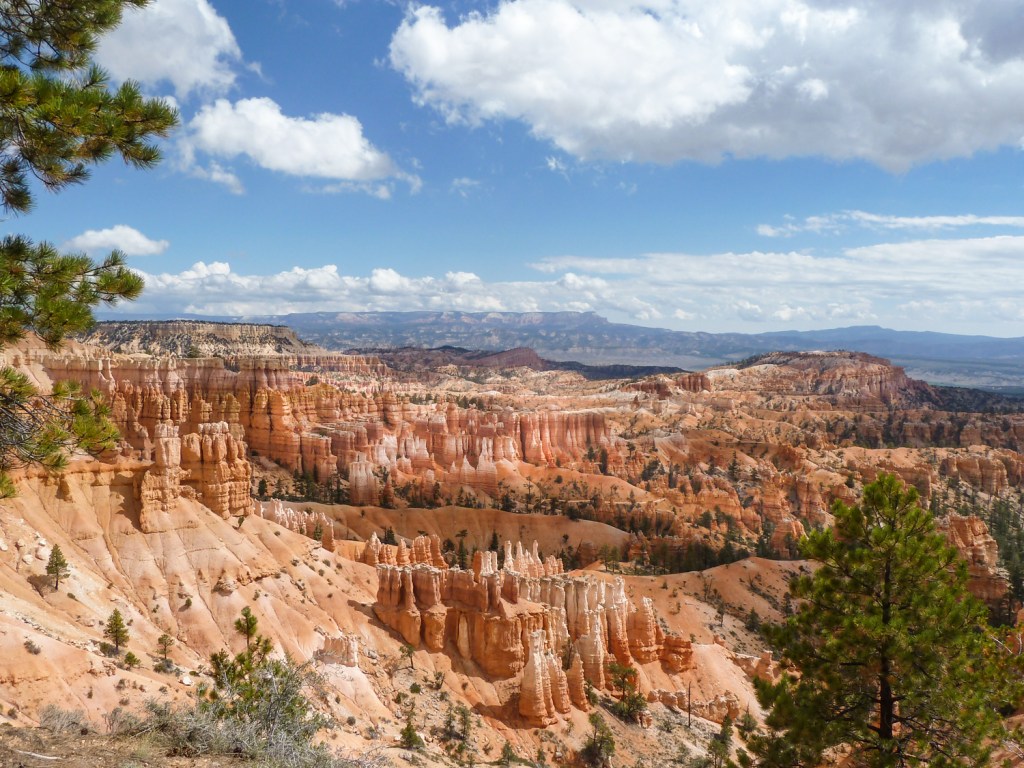
A view of the canyon along the Fairyland Trail.
At Sunrise, catch a jaw-dropping view of Boat Mesa, above the hoodoos of Fairyland Canyon, and the Sinking Ship, tilted rocks that serve as an ongoing reminder of the violent tectonic activity that began shaping the area more than 15 million years ago. From Sunset Point, Thor’s Hammer, the Silent City, and the Pink Member (where pink and purple hues mark the rock thanks to manganese oxide deposits) can all be seen. For a closer view, hit the Navajo Loop Trail to descend into the canyon, and as you do, keep an eye out for the birds—violet-green swallows, cliff swallows and white-throated swifts—that dart between the hoodoos. Inspiration Point offers a three-tiered perspective of the Bryce Amphitheater; the Silent City makes an appearance, as do barren slopes dotted with gnarled bristlecone pines. Ironically, it’s at Bryce Point where you won’t want to miss the sunrise. As the sun’s first rays splay across the amphitheater, the tips of hoodoos are set ablaze in searing oranges and reds.
Navajo Loop Trail
From the Sunset Point parking area, this popular 1.4-mile hike switchbacks steeply down among hoodoos in a canyon awash in color. At first, the trail is wide and easy to follow before it tapers at the beginning of Wall Street, a narrow slot wedged between sheer cliffs. At the bottom, the cliffs open to a wide valley where sunlight filters through towering Douglas-fir trees. The trail’s eastern section offers a stellar view of Thor’s Hammer. If you’re looking for something longer, combine this short trail with the Queen’s Garden Trail or the Peekaboo–Navajo Connector, each for an added three miles.
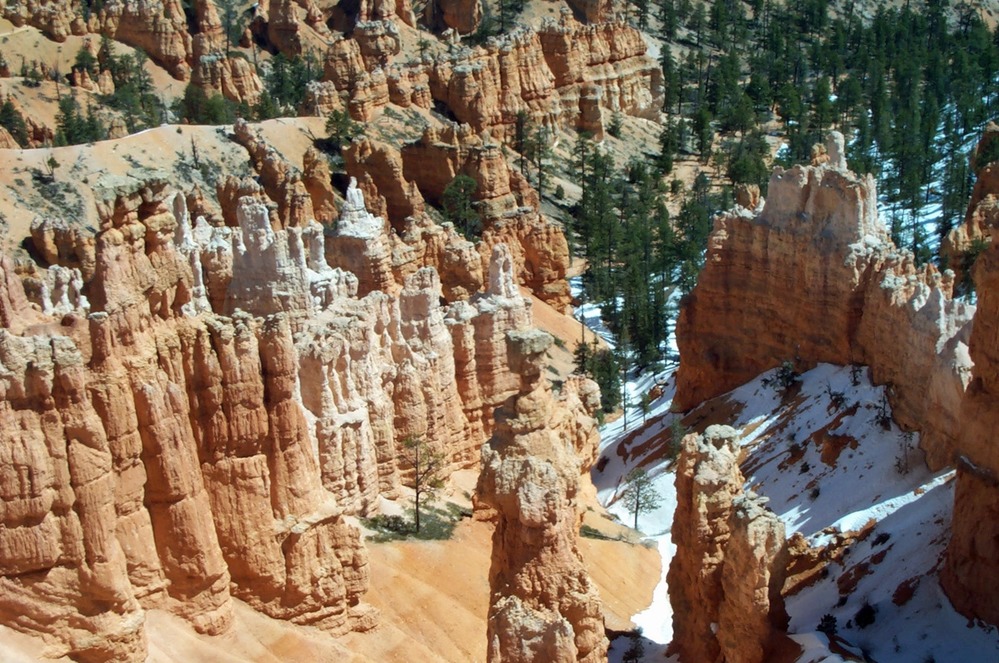
Looking down on Thor’s Hammer from the top of the Navajo Loop Trail. (Photo courtesy of the National Park Service)
Mossy Cave Trail & Bristlecone Loop Trail
These scenic, short hikes are perfect for families. Mossy Cave Trail, just 0.8 miles out and back, is where Mormon pioneers in the early 1890s carved an irrigation canal from the East Fork of the Sevier River. It boasts a small waterfall and Mossy Cave, a grotto formed by an underground spring with an overhang that is covered in moss—or in the winter, draped with icicles. The one-mile Bristlecone Loop Trail treads over the highest portion of the park, reaching 9,100 feet of elevation as it meanders through spruce and fir forest and passes by bristlecone pines that are up to 1,800 years old.
Under-the-Rim Trail
For serious backpackers looking to ditch the crowds, look no further than the Under-the-Rim Trail, a 22.7-mile, three-day trek through amphitheaters, hoodoo-dotted canyons and dense forests. It’s a north-to-south trail, beginning at Bryce Point and ending at Rainbow Point (or vice versa), and both can be reached by the park’s shuttle service. The benefits: solitude, rugged beauty, aromatic piñon pines and creekside willows. The downfalls: precious little clean water. Load up on water before you go and make sure to boil what you find. Otherwise, enjoy disappearing into this seldom-visited slice of the park.
Stargazing
Bryce Canyon has been called “the last grand sanctuary of natural darkness,” by the National Park Service, due to its lack of light pollution and superior air quality. Since 1969, the park has hosted regular nighttime viewing sessions led by rangers well-versed in astronomy. Also known as “Astronomy Rangers,” these guides curate stargazing sessions for visitors who want to learn more about the night sky. Visitors can catch full views of the Milky Way’s swirling colors and even see shadows cast by the brightness of Venus and Jupiter. Diehard stargazers can attend the park’s annual astronomy festival, assisted by the Salt Lake Astronomical Society (SLAS), while lunar lovers should schedule their visit to coincide with a full moon and ranger-led full moon hikes.

The soaring rock fins of Wall Street at sunset. (Photo courtesy of the National Park Service)
How to Visit Bryce Canyon National Park
From wandering trails that delve deep into the backcountry to scenic drives that wind along the view-packed amphitheater rim, there are lots of ways to uncover Bryce Canyon’s best sights. Keep an eye out for ranger-led hikes that highlight the park’s unique features, like full-moon hikes, stargazing sessions and snowshoe excursions.
Activities in Bryce Canyon National Park
Hiking
Link the viewpoints along the rim of the Bryce Amphitheater, wander through the forests of the plateau, explore the hoodoos in the valleys below and gaze at the celestial night sky. Bryce Canyon, with everything from paved walks to backcountry trails, has something for everyone. Families and visitors with limited time can hop on short scenic jaunts like Mossy Cave Trail and the Bristlecone Loop, or join a ranger-guided rim walk or full moon hike. With a little more time, the Rim Trail travels 5.7 miles along the entire rim of the amphitheater and is paved from Sunset Point to Sunrise Point. Those who seek the backcountry will be rewarded on the 8.4-mile Riggs Spring Loop Trail, which drops below the rim of the plateau down to the forested valleys below and offers four backcountry campsites to choose from. The truly hardy will find the 22.7-mile Under-the-Rim Trail a worthy challenge.
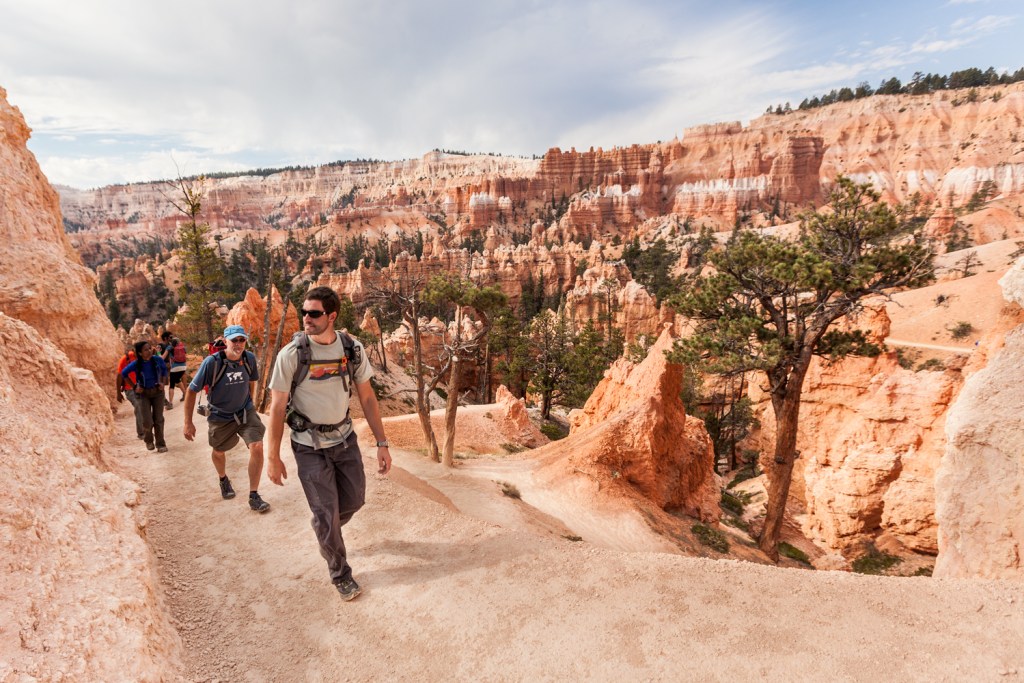
Hiking opportunities abound in the heart of Bryce.
Scenic Driving
The best views of the park are found at the many scenic overlooks that dot the 18 miles of Highway 63 that traverses the main section of the park. As you drive south, all of the park’s overlooks—Sunrise, Sunset, Inspiration and Bryce viewpoints, among many others—lie on the east side of the park road; that is, on the left. To get a close-up view of the red-rock spires, hang a left off the road just one mile south of the park boundary for the road to Fairyland Canyon, where the hoodoos are at eye level.
Horseback Riding
Trade your trekking poles for reins and hitch a ride to the Bryce Amphitheater on the back of a horse or mule from spring through fall. The wranglers at the Canyon Trail Rides offer two- to four-hour rides into the amphitheater on a dedicated horse trail and the Peek-A-Boo Loop Trail, an experience unlike any other in the park.
Winter Sports
Winter is when the colors of Bryce Canyon really begin to pop. Brilliant white snow offers a stark contrast to the red, pink and orange hues of the rock spires and cliffsides. Both the Fairyland Road and Paria Point Road are left unplowed for cross-country skiers and snowshoers, and most of the park’s other trails remain open to those with snowshoes or with added traction on their hiking boots, like mountaineering crampons. For a guided look at Bryce’s frozen features, hop on one- to two-mile ranger-led snowshoe hikes that leave from the visitor center after big snowfalls.
Cycling and Mountain Biking
Inside the park, all roads are open to cyclists, but trails and off-trail areas are prohibited to riders. Road cyclists can test their endurance on Scenic Byway 12, which cuts through the northeast corner of Bryce Canyon. Steep elevation gains and loads of switchbacks make it a tough ride, but the sweeping views are sure to soothe your sore legs.
Mountain bikers can get their thrills on open trails just outside the park, like Thunder Mountain Trail, a one-way 8.1-mile stretch of singletrack that passes through ponderosa pines over mostly smooth hard track to reach unbelievable views of Thunder Mountain. For rides packed with red rocks and pine forests, hit the Casto Canyon Trail (5.5 miles, one way) or the Cassidy Trail (8.9 miles, one way), which is believed to have been named after Butch Cassidy, the gunslinging outlaw who once roamed these parts.
Where to Stay Near Bryce Canyon
Bryce Canyon is fairly small—only 55 square miles—and remote, which means that there are limited options for campgrounds and places to stay in or near the park. But, with some advance planning or an adventurous spirit, finding a place to hang your trekking poles at the end of the day shouldn’t be too challenging.
Car Camping
Bryce has two campgrounds, Sunset Campground (100 sites) and North Campground (99 sites), both located near the visitor center and Bryce Amphitheater. Sunset Campground is closed from mid-October to mid-April, though North Campground is open year-round. Both have drinking water, but they do not have electrical or water hookups for RVs. A limited number of sites are available for reservations, and the rest are available on a first-come, first-serve basis.
Backcountry Camping
Escape the crowds and dive into the backcountry of Bryce Canyon to get a closer look at its unique geology and ecology. Backcountry permits are available for $5 at the visitor center, up to 48 hours in advance. Two trails that offer access to backcountry camping: the Under-the-Rim Trail (22.7 miles, 8 campsites) and the Riggs Spring Loop (8.9 miles, 4 campsites). Camping is only permitted in designated campsites.
The Lodge at Bryce Canyon
Rooms fill up fast at this historic lodge built in 1924. Just a short stroll from the Bryce Amphitheater, the lodge features 70 rustic rooms, 40 cabins, three suites and a studio. The lodge also features a gift shop and a restaurant open for breakfast, lunch and dinner.
Towns
Small towns are scattered around Bryce Canyon National Park and offer a host of accommodations and places to eat. Bryce (one mile from the park) is the closest and is served by the Bryce Canyon Shuttle. Tropic (10 miles from the park) and Cannonville (15 miles from the park) are good bases for those who also want to visit Grand Staircase-Escalante National Monument; and Hatch (24 miles from the park) is situated conveniently on Highway 89 for quicker access to Zion and the Grand Canyon.
Best Times to Visit Bryce Canyon National Park
There are year-round opportunities to enjoy Bryce Canyon National Park, but keep in mind that its high elevation makes cooler temperatures the norm for much of the year. Even in summer, daily highs rarely go much above 80 degrees.
- Spring: Wildflowers begin to burst open in the park’s alpine meadows, and fresh snowmelt reawakens meandering streams. Expect temperatures in the 50s and 60s during the day and about 30 degrees cooler at night.
- Summer: This is the most popular time of year, when daytime temps reach the high 70s and low 80s. Counter to normal seasonal shifts, summer is actually the time with the most rainfall in Bryce Canyon. Be prepared for frequent but short thunderstorms and equally dramatic downpours.
- Fall: Fall foliage erupts in the lower elevations and crowds begin to thin out as autumn sets in. Consider cooler temperatures in your planning as snowfall isn’t uncommon as early as October.
- Winter: Snow begins in earnest in December, so set aside the hiking boots in favor of snowshoes and cross-country skis. Winter is also the best time for guided full moon snowshoeing hikes and winter astronomy programs.
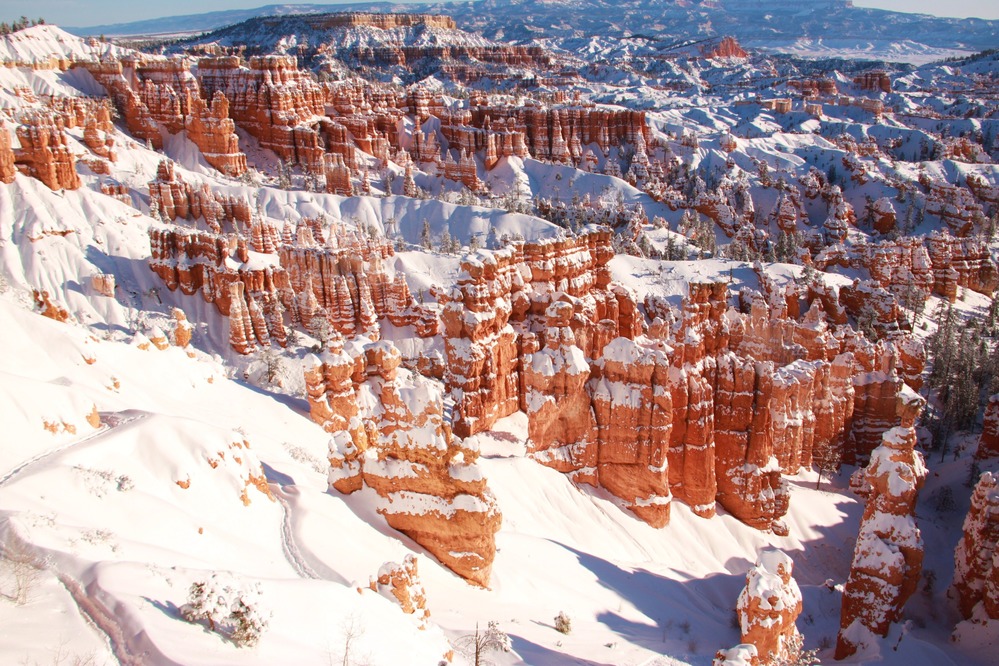
Bryce Canyon under a blanket of fresh snow. (Photo courtesy of the National Park Service)
Travel Planning
Airports
The closest airports to Bryce Canyon are Salt Lake City International Airport (SLC) and McCarran International Airport (LAS) in Las Vegas. A four-hour drive separates both airports from the park entrance, making a car rental a necessity for most air-bound travelers.
Visitor Center
The Bryce Canyon Visitor Center is located near the park’s northern boundary. It’s open year-round with the exception of holiday closures on Thanksgiving, Christmas and New Year’s Day. Hours of operation are typically from 8am to 6pm in the spring through fall, and 8am to 4:30pm in the winter. Visitors can get info about the park, obtain backcountry permits, fill up water bottles, enjoy an informative video about the park and hear short ranger-led talks about the area’s geology.
Parking
Inside the park, parking is extremely limited and increases your park entrance fee from $20 to $35. There is no additional charge for visitors who hold an annual federal recreation pass.
Bryce Canyon Shuttle
To get into the park without your car, or to explore the park without having to lose your parking spot, the Bryce Canyon Shuttle offers regular service between the visitor center, parking lots, nearby accommodations and points of interest. The shuttle is free with your park entrance fee.
Special Considerations (High Altitude)
Bryce Canyon National Park ranges from 6,300 feet to more than 9,000 feet in elevation. In general, expect freezing nightly temperatures from October to May, always dress in layers, stay hydrated and remember to wear sunscreen. Hikers should expect to take a few days to acclimate to the higher altitude and may experience shortness of breath on their first outings.
